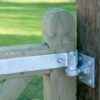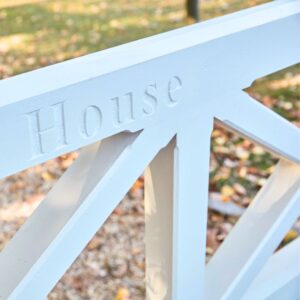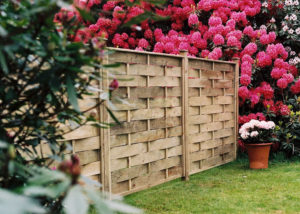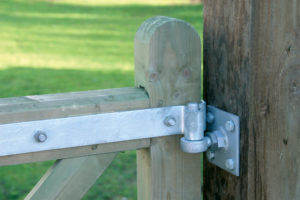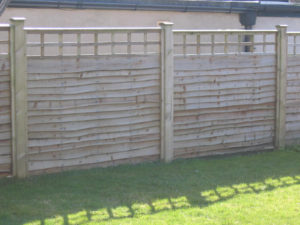Understanding boundaries and the legal height, location and toppers for fences can be a mine field of information and legislation. Here you will find some basic advice, tips and general information to consider, when you are making the decision to erect a new fence in your garden or replace an old one.
FENCES – LEGAL HEIGHTS
Is planning permission required to erect a fence?
No, as long as it is not over 2m tall, or 1m if it is adjacent to a highway / street. If you are planning to include any additional items at the top of the fence i.e. trellis, wire or brackets to carry a climbing shrub these should be included in the 2m limit of the overall height.
However, there are no planning restrictions on growing a thorny plant along the top of a 2m fence, providing there are no support structures in place. These are used by many to deter fence climbing as they are natural defenders and outside of legislation.
Additionally by adding items such as barbed wire, anything with spikes or jagged projections (including carpet grippers, broken glass, nails etc.) to a fence that adjoins a highway, even when the fence and toppers are within the 1m height restriction, a notice could be served for removal as most highway agencies consider things that can cause injury lower than 2.4m to be a nuisance. Clear signage, warning of an injurious topper, on a fence will limit liability, provided that it is specific to the risk. However no items should be put on the inside face of the fence or be otherwise hidden.
Erecting a fence
Posts should be entirely on your land
The face of the fence should point to your neighbour
NB: With specific reference to fences that sit between fence posts i.e. larch lap fencing, the side where the top strip overlaps the lower strip should face towards your neighbours garden.
Ownership
If the fence belongs to one property owner they can use it as they wish – without the neighbours consent, as long as it is safe. NB: Always read the notes within the title deeds of your property as they may specify the type of boundary i.e. a wooden fence.
If it is jointly owned – each neighbour can use the fence for support, i.e. for trailing plants, as long as neither makes it unsafe.
Duty to erect – you do not have to erect or maintain a fence; though some exceptions do exist including but not exclusive of:
- Clauses within the title documents
- The property is next to a street / highway
- Land is used for dangerous purposes
ALWAYS CHECK YOUR POSITION WITH REGARDS TO THE BOUNDARY BEFORE MAKING ANY CHANGES!
Repair
The property owner does not have to repair a fence (unless stated in title documents). However if the fence causes damage or injury you could be taken to court for compensation. If the fence is next to a highway it should be kept in good repair to prevent it becoming a nuisance or danger to people using the street.
FENCES – ESTABLISHING BOUNDARIES
Boundary disputes can cause stress and ill feeling amongst neighbours, so prevention is always better than cure!
What is a boundary?
Legal Boundary Physical Boundary
Imaginary or invisible line that divides one property from another.
Fence, wall or hedge – this may or may not follow the line of a legal Boundary.
(A physical boundary may change over time for many reasons for example – a wooden fence that moves slightly every time it is replaced etc.)
TIP – When you move into a property go upstairs and take photographs of how the boundaries lie, date them and store them away. Every year from then on in take another set of photographs from the same place for future reference.
If a disagreement does arise COMMUNICATION IS KEY as minor disagreements can so easily become full scale disputes that are expensive to resolve.
How to resolve a dispute
Amicable discussion
Pull together any documents you have referencing or establishing the boundaries of the property i.e. Title Deeds. A copy of the plan, registered at HM land registry, can be obtained for your own and anyone else’s property (as long as they are registered). Clear evidence establishing ownership is usually conclusive. NB: Boundaries shown on a plan are only a general indication.
Consult a solicitor
If initial disussions don’t go well secure legal advice, speak to a solicitor and show them your documentation.
Mediation
If negotiation fails, attempt a mediation involving both parties and their legal representation and an independent mediator.
Court
This is always a last resort, but should all other avenues of resolution fail the matter can be taken to court for a judge to decide.
Title Deeds
The red line shown on these, around a property, is only a general indication of a boundary.
‘T’ marks normally indicate that the property within the red edging is responsible for maintenance / repair of any boundary. However the wording within the deed must always be read.
A rule of thumb – If nothing is stated in the title deeds, about the boundary, in the case of fences – the property with the posts and / or shrubs on their side is seen as the owner and responsible for repairing the fence.
Lastly, always remember, disputes don’t only occur with relation to residential properties – commercial and agricultural land can also be at the centre of a dispute!


